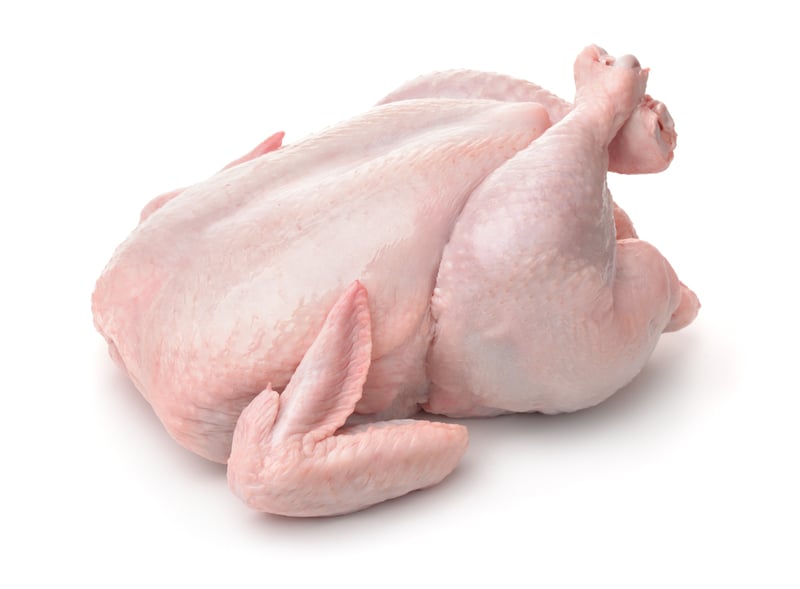Lab-Grown Chicken Is Real… But Is It Healthy?

Whether you call it lab-grown chicken, cultivated meat, cultured-cell chicken, no-kill meat, slaughter-free chicken, more humane meat, etc., it’s one of the biggest developments in the food industry, well, ever. Currently, two companies (Upside Foods and GOOD Meat) have received the first steps in the FDA (Food and Drug Administration) approval process to bring meats grown in bioreactors to the U.S. market as of November of 2022. In other words, according to the FDA, lab-grown chicken has been determined to be “safe for human consumption.”
Regulators from the U.S. Department of Agriculture (USDA) are now putting together the rules and guidelines for how to label and inspect these foods and the locations where they’re being produced to be sold throughout the United States.
This is novel and big news. Yet, lab-grown chicken has been under development for years. And as of 2020, one brand of lab-grown chicken (GOOD Meat) has been available to buy and, yes, eat in Singapore. A hundred or more companies (e.g., Mosa Meat of the Netherlands and Believer Meats of Israel) are making efforts to create meat far from the often less humane, less clean factory farms that produce most of the animal products we consume.
The Issues with Factory-Farmed Chickens
Many of us like to picture the chicken we eventually consume spending most (if not all) of their lives frolicking in fields, consuming a wide variety of the seeds and insects they prefer before being humanely killed and butchered in a spotless facility. (And there are farmers who do provide this quality of life and cleanliness for the animals they raise.)
Unfortunately, though, most of the chicken produced comes from another type of “farm,” or more accurately, factory farm. Even if the marketing materials provide idyllic images, unless you are raising the chickens yourself or purchasing them from a local farmer, they’re more likely coming from factory farms.
On these factory farms, the birds are crowded together in large sunless barns that take up huge areas of land and require loads of water, feed, antibiotics, and other drugs to help stave off disease. In addition, because temperature control is important, these facilities typically take tons of energy to run. These facilities also create astounding amounts of waste, which can contaminate water, soil, and food growing in surrounding areas.
What’s more, most of us have felt the pain in our wallets when disease, such as bird flu, takes over, and large amounts of animals must be culled from the flock to help prevent the spread. This can damage the bottom line for both family farmers and factory farmers, not to mention skyrocketing costs of foods around the country.
Again, there are big differences between producers, and many farms take great care in ensuring their chickens are well cared for, clean, and healthy. Others, unfortunately, do little for the birds and can even become abusive as decisions are made far from where the chickens are raised, and the animals are treated more like parts than the living creatures they are.
Beyond ethical concerns are the environmental impacts. Worldwide, animal agriculture makes up 14.5%+ of greenhouse gas—by some estimates, that’s almost equal to the combined transportation emissions from cars, trucks, ships, and airplanes, though most of that is due to methane from cows.
Why Lab-Grown Chicken?
With environmental and ethical concerns as top priorities, some people choose to steer clear of eating meats like chicken altogether and consume plant-based diets. Others choose to eat only those animals they raise or hunt themselves or that have been raised by local farmers in the area who ensure the animals have access to fresh air, clean food, and room to roam.
Now, a new option is expected to become available in restaurants and grocery stores in the next year or so. Lab-grown chicken is made by taking cells from live animals and cultivating these cells in a mixture of nutrients like fats, sugars, oxygen, and vitamins. The process creates real meat tissue that tastes like meat, looks like meat, and has the same (or even better) nutrient profile as meat. However, no animals are raised, slaughtered, and then butchered for the meat.
Some of the potential benefits of lab-grown chicken and other meats include:
- Reduces (or potentially eliminates) suffering and unethical treatment for factory-farmed animals (every year 50 billion chickens are slaughtered for food).
- Friendlier to the environment as it uses up to 99% less land and 82 to 96% less water and 7 to 45% less energy.
- Greenhouse gas emissions and other pollutants (such as from animal waste) are drastically reduced (by 78 to 96%).
- Other animal meats—such as beef, pork, lamb, and seafood—can be produced.
- Improved food safety due to cleaner conditions.
- Dramatically expanded food supply worldwide.
Downsides of lab-grown chickens:
- Because significant investment in infrastructure is needed, cultured chicken is likely to be much more expensive than conventionally produced chicken (at least in the beginning).
- Industry financial viability hasn’t yet been determined—lab-grown meat is expensive, and scalability hasn’t yet been determined.
- Cultured chicken meat will be hitting upscale restaurants before it’s available in local grocery stores. Even then, the price is expected to be higher than organic, though manufacturers hope to have pricing in line with conventional chicken within 5 to 15 years.
- Concerns over the labeling of cultivated meat products and educating consumers to ensure they understand what they’re consuming.
- Some researchers believe the environmental impacts haven’t been determined and the proponents may be overly optimistic because bioreactors also use large amounts of energy.
- Plant-based foods, including those high in protein, already have a healthy track record for safety, sustainability, and affordability.
How is Lab-Grown Chicken?
Lab-grown meat is cultivated by taking cells from high-quality livestock animals. The cells are then introduced into a clean and controlled bioreactor that’s filled with a broth bath that’s rich in a steady flow of nutrients. The cells then begin to grow, surrounded by essential nutrients needed to replicate and mature. Once they’re differentiated into the various components (e.g., fat, muscle, or structural cells), they’re then moved to a larger bioreactor. There, they grow for around two to four weeks until the meat is ready and can be packaged, cooked, or otherwise prepared to eat.
RELATED: Collagen Doesn’t Work (Unless…)
The process creates real meat tissues without the need to feed, raise, and ultimately slaughter a live animal. Ground meat takes less time than chicken filets, which are more complex and may need to be shaped with a 3D bioprinter. 1
Cultivating meat may sound entirely novel, but it uses a technique that’s more than 100 years old and has been used to grow muscle tissue in vitro. Cultivating meat is much like brewing beer as it uses cell culture and fermentation technology. However, while beer is produced by growing yeast or bacteria, to grow meat, they start with animal cells. After the meat is produced, before it’s delivered to consumers, it must go through a thorough regulatory process.
According to the FDA, they are supporting food technology innovations, yet they are also prioritizing the production of safe food. “Human food made with cultured animal cells must meet the same stringent requirements, including safety requirements as all other food.”
The USDA will also be involved to ensure manufacturing facilities are clean and safe and the meat is inspected before being sold.
What does the lab-grown chicken taste like? According to those who have eaten it, it tastes like… chicken. Some reports suggest it offers more of a natural chicken flavor than typical bland factory-farmed chicken as the cells are selected for their high-quality farm-breed flavor and the medium is designed to enhance taste as well as the firm, meaty consistency of whole chicken.
Is Lab-Grown Chicken Healthier?
According to researchers, because of the technology, it’s possible for lab-grown meat to be even higher in essential amino acids and healthy fats than conventionally produced meats. Depending on the nutrients in the broth solution, it may also be higher in vitamins, minerals, and other nutrients, making it a functional food.
Because it’s also produced in a sterile environment with greater quality control, exposure to contamination (including from antibiotics) is limited, so it may be safer as well. 2
That said, until larger amounts of the meats are produced, we don’t have the answers on how much healthier lab-grown chicken will really be.
Perhaps the biggest question is: Will lab-grown chicken help feed the world as the population surges past the expected 9.1 to 9.5 billion by 2050? Researchers and innovative manufacturers hope so. And it does hold promise as many animals can be grown from the cells from only one animal for years, using less room and resources to boot. But only time will tell…




 7 Signs Your Body is Seriously Low on Collagen (not just wrinkles)
7 Signs Your Body is Seriously Low on Collagen (not just wrinkles) Health Expert: "Turmeric Doesn't Work (unless...)"
Health Expert: "Turmeric Doesn't Work (unless...)" 3 Warning Signs Your Probiotic Supplement is a Total Waste
3 Warning Signs Your Probiotic Supplement is a Total Waste

